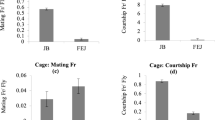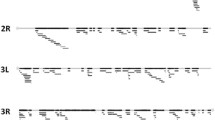Abstract
Darwinian fitness in holometabolous insects like the fruit fly Drosophila melanogaster is reported to be positively correlated with body size. If large individuals in a population have higher fitness, then one would expect directional selection to operate leading to uniformly large individuals. However, size polymorphism persists in nature and needs further probing. We assessed the effect of body size on some of the fitness and fitness-related traits in replicate populations of genotypically large, genotypically small and phenotypically small D. melanogaster flies. In this study, the time taken to attain reproductive maturity and copulation duration were independent of fly size. Fecundity and longevity of large females were significantly higher when they partnered genotypically small males than when they were with genotypically larger or phenotypically small males. The increased female longevity when in association with genotypically small males was not due to selective early death of males that would release the female partner from presumed cost of persistent courtship. On the contrary, the genotypically as well as phenotypically small males had significantly higher longevity than large males. The virility of the genotypically small males was not significantly different from that of genotypically large males. Our results clearly show that selection on body size operates in the opposite direction (disruptive selection) for the two genders, thus explaining the persistence of size polymorphisms in the holometabolous insect, Drosophila melanogaster.







Similar content being viewed by others
Abbreviations
- Acps:
-
Accessory gland proteins
- AG:
-
Accessory gland
- CD:
-
Copulation duration
- GL:
-
Genotypically large flies
- GS:
-
Genotypically small flies
- PS:
-
Phenotypically small flies
- RM:
-
Reproductive maturity
- SFPs:
-
Seminal fluid proteins
- SLC:
-
Standard laboratory conditions
- SM:
-
Standard banana-jaggery media
References
Abbott JK, Bedhomme S and Chippindale AK 2010 Sexual conflict in wing size and shape in Drosophila melanogaster. J. Evol. Biol.. 23 1989–1997
Ackermann M, Bijlsma R, James AC, Partridge L, Zwaan BJ and Stearns SC 2001 Effects of assay conditions in life history experiments with Drosophila melanogaster. J. Evol. Biol. 14 199–209
Archer MA, Phelan JP, Beckman KA and Rose MR 2003 Break down in correlations during laboratory evolution. II. Selection on stress resistance in Drosophila populations. Evolution 57 536–543
Aspi J and Hoikkala A 1995 Male mating success and survival in the field with respect to size and courtship song characters in Drosophila littoralis and D. montana (Diptera: Drosophilidae). J. Insect Behav. 8 67–87
Baker RH, Denniff M, Futerman P, Fowler K, Pomiankowski A and Chapman T 2003 Accessory gland size influences time to sexual maturity and mating frequency in the stalk-eyed fly, Cyrtodiopsis dalmanni. Behav. Ecol. 14 607–611
Bangham J, Chapman T and Partridge L 2002 Effects of body size, accessory gland and testis size on pre and postcopulatory success in Drosophila melanogaster. Anim. Behav. 64 915–921
Barnes AI, Wigby S, Boone JM, Partridge L and Chapman T 2008 Feeding, fecundity and lifespan in female Drosophila melanogaster. Proc. R. Soc. B 275 1675–1683
Blanckenhorn WU 2000 The evolution of body size: what keeps organisms small? The Quart. Rev. Biol. 75 385–407
Bretman A, Westmancoat JD, Gage MJG and Chapman T 2013 Costs and benefits of lifetime exposure to mating rivals in male Drosophila melanogaster. Evolution 67 2413–2422
Chandrashekara KT and Shakarad MN 2011 Aloe vera or resveratrol supplementation in larval diet delays adult aging in the fruit fly, Drosophila melanogaster. J. Gerontol. 66 965–971
Chapman T, Liddle LF, Kalb JM, Wolfner MF and Partridge L 1995 Cost of mating in Drosophila melanogaster females is mediated by male accessory gland products. Nature 373 241–244
Chapman T, Arnqvist G, Bangham J and Rowe L 2003 Sexual conflict. Trends. Ecol. Evol. 18 41–47
Chippindale AK, Alipaz JA, Chen HW and Rose MR 1997a Experimental evolution of accelerated development in Drosophila. 1. Developmental speed and larval survival. Evolution 51 1536–1551
Chippindale AK, Leroi AM, Saing H, Borash DJ and Rose MR 1997b Phenotypic plasticity and selection in Drosophila life history evolution. 2. Diet, mates and the cost of reproduction. J. Evol. Biol. 10 269–293
Chippindale AK, Ngo AL and Rose MR 2003 The devil in the details of life-history evolution: instability and reversal of genetic correlations during selection on Drosophila development. J. Genet. 82 133–145
Fisher LD and Van BG 1993 Biostatistics: A methodology for the health sciences (New York: Wiley) pp 786–843
Friberg U 2006 Male perception of female mating status: its effect on copulation duration, sperm defense and female fitness. Anim. Behav. 72 1259–1268
Gilchrist AS and Partridge L 2000 Why it is difficult to model sperm displacement in Drosophila melanogaster: the relation between sperm transfer and copulation duration. Evolution 54 534–542
Heifetz Y, Lung O, Frongillo EA and Wolfner MF 2000 The Drosophila seminal fluid protein Acp26Aa stimulates release of oocytes by the ovary. Curr. Biol. 10 99–102
Imroze K and Prasad NG 2011 Mating with large males decreases the immune defense of females in Drosophila melanogaster. J. Genet. 90 427–434
Kraaijeveld K, Denniff M, Baker RH and Chapman T 2008 The evolution of sperm and non-sperm producing organs in male Drosophila. Biol. J. Linn. Soc. 94 505–512
Lefranc A and Bundgaard J 2000 The influence of male and female body size on copulation duration and fecundity in Drosophila melanogaster. Hereditas 132 243–247
Macbean IT and Parsons PA 1967 Directional selection for duration of copulation in Drosophila melanogaster. Genetics 56 233–239
Markow TA and Ricker JP 1992 Male size, developmental stability, and mating success in natural populations of three Drosophila species. Heredity 69 122–127
Nunney L 1996 The response to selection for fast larval development in Drosophila melanogaster and its effect on adult weight: an example of a fitness trade-off. Evolution 50 1193–1204
Parker GA 1979 Sexual selection and sexual conflict; in Sexual selection and reproductive competition in insects (eds) MS Blum and NA Blum (London: Academic Press) pp 123–166
Partridge L and Farquhar M 1983 Lifetime mating success of male fruitflies (Drosophila melanogaster) is related to their size. Anim. Behav. 31 871–877
Partridge L and Fowler K 1990 Non-mating costs of exposure to males in female Drosophila melanogaster. J. Insect Physiol. 36 419–425
Partridge L, Ewing A and Chandler A 1987 Male size and mating success in Drosophila melanogaster: the roles of male and female behaviour. Anim. Behav. 35 555–562
Pavkovic-Lucic S and Kekic V 2013 Developmental temperature, body size and male mating success in fruit flies, Drosophila melanogaster (Diptera: Drosophilidae). Eur. J. Entomol. 110 31–37
Peng J, Chen S, Busser S, Liu H, Honegger T and Kubli E 2005 Gradual release of sperm bound sex-peptide controls female postmating behavior in Drosophila. Curr. Biol. 15 207–213
Phelan JP, Archer MA, Beckman KA, Chippindale AK, Nusbaum TJ and Rose MR 2003 Breakdown in correlations during laboratory evolution. I. Comparative analyses of Drosophila populations. Evolution 57 527–535
Pitnick S 1991 Male size influences mate fecundity and remating interval in Drosophila melanogaster. Anim. Behav. 41 735–745
Pitnick S 1996 Investment in testes and the cost of making long sperms in Drosophila. Am. Nat. 148 57–80
Pitnick S and Garcia-Gonzalez F 2002 Harm to females increases with male body size in Drosophila melanogaster. Proc. R. Soc. Lond. B 269 1821–1828
Pitnick S, Spicer GS and Markow TA 1995 How long is a giant sperm? Nature 375 109
Prasad NG and Joshi A 2003 What have two decades of laboratory life-history evolution studies on Drosophila melanogaster taught us? J. Genet. 82 45–76
Prasad NG and Shakarad MN 2004 Genetic correlations: transient truths of adaptive evolution. J. Genet. 83 3–6
Prasad NG, Shakarad M, Anitha D, Rajamani M and Joshi A 2001 Correlated responses to selection for faster development and early reproduction in Drosophila: The evolution of larval traits. Evolution 55 1363–1372
Prasad NG, Shakarad M, Gohil VM, Sheeba V, Rajamani M and Joshi A 2000 Evolution of reduced pre-adult viability and larval growth rate in laboratory populations of Drosophila melanogaster selected for shorter development time. Genet. Res. 76 249–259
Roff DA 1981 On being the right size. Am. Nat. 118 405–422
Roff DA 1992 The evolution of life histories: theory and analysis (New York: Chapman and Hall)
Rush B, Sandver S, Bruer J, Roche R, Wells M and Giebultowicz J 2007 Mating increases starvation resistance and decreases oxidative stress resistance in Drosophila melanogaster females. Aging Cell 6 723–726
Schneider CA, Rasband WS and Eliceiri KW 2012 NIH Image to ImageJ: 25 years of image analysis. Nat. Methods 9 671–675
Scott D 1987 The timing of the sperm effect on female Drosophila melanogaster receptivity. Anim. Behav. 35 142–149
Sirot LK, Buehner NA, Fiumera AC and Wolfner MF 2009 Seminal fluid protein depletion and replenishment in the fruit fly, Drosophila melanogaster: an ELISA-based method for tracking individual ejaculates. Behav. Ecol. Sociobiol. 63 1505–1513
Sisodia S and Singh BN 2004 Size dependent sexual selection in Drosophila ananassae. Genetica 121 207–217
Sokal RR and Rolf JF 1995 Biometry: the principles and practice of statistics in biological research, 3rd ed (Freeman and Company)
Tregenza T, Wedell N and Chapman T 2006 Introduction. Sexual conflict: a new paradigm? Phil. Trans. R. Soc. B 361 229–234
Wolfner MF 2002 The gifts that keep on giving: physiological functions and evolutionary dynamics of male seminal proteins in Drosophila. Heredity 88 85–93
Zwaan BJ, Bijlsma R and Hoekstra RF 1995 Artificial selection for development time in Drosophila melanogaster in relation to the evolution of aging: direct and correlated responses. Evolution 49 635–648
Acknowledgements
We thank two anonymous reviewers for their critical comments that helped in improving the quality of presentation. This research was supported by Council of Scientific and Industrial Research, Government of India EMR grant and University of Delhi R and D grant to MS. KTC and KK thank the Council of Scientific and Industrial Research for Post-doctoral and Junior Research Fellowships respectively. GS thanks University Grants Commission for Junior Research Fellowship. JH thanks Department of Zoology, University of Delhi, for Non-NET Fellowship.
Author information
Authors and Affiliations
Corresponding author
Additional information
Corresponding editor: Subhash C Lakhotia
[Handa J, Chandrashekara KT, Kashyap K, Sageena G and Shakarad MN 2014 Gender based disruptive selection maintains body size polymorphism in Drosophila melanogaster. J. Biosci. 39 1–12] DOI 10.1007/s12038-014-9452-x
Rights and permissions
About this article
Cite this article
Handa, J., Chandrashekara, K.T., Kashyap, K. et al. Gender based disruptive selection maintains body size polymorphism in Drosophila melanogaster . J Biosci 39, 609–620 (2014). https://doi.org/10.1007/s12038-014-9452-x
Received:
Accepted:
Published:
Issue Date:
DOI: https://doi.org/10.1007/s12038-014-9452-x




